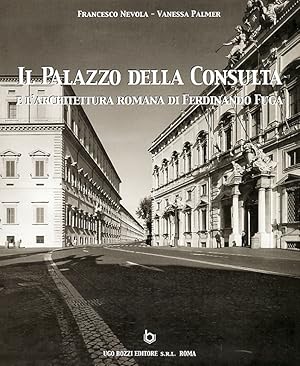francesco nevola vanessa palmer (4 risultati)
Tipo di articolo
- Tutti gli articoli
- Libri (4)
- Riviste e Giornali
- Fumetti
- Spartiti
- Arte, Stampe e Poster
- Fotografie
- Mappe
-
Manoscritti e
Collezionismo cartaceo
Condizioni
Legatura
- Tutte
- Rilegato (3)
- Brossura
Ulteriori caratteristiche
- Prima edizione
- Copia autografata
- Sovraccoperta
- Con foto (3)
- No print on demand
Paese del venditore
Valutazione venditore
-
il palazzo della consulta e l'architettura romana di ferdinando
Editore: , ugo bozzi editore, 2004
Da: Luens di Marco Addonisio, Torino, Italia
Condizione: Buono (Good). francesco nevola vanessa palmer il palazzo della consulta e l'architettura romana di ferdinando. , ugo bozzi editore 2004 italiano, 491 °°°°rilegato presente cartone editoriale cartone editoriale con lievi segni di usura sovracopertina con lievi segni di usura tracce di polvere presenti interni buoni . Book.
-
Il Palazzo della Consulta e l'architettura romana di Ferdinando Fuga
Editore: Ugo Bozzi Editore, Roma, 2004
ISBN 10: 8870030377ISBN 13: 9788870030372
Da: Il Salvalibro s.n.c. di Moscati Giovanni, Foligno, PG, Italia
Libro
Condizione: As New. Mm 255x290 Volume rilegato in similpelle editoriale blu con sovraccoperta e custodia rigida figurate, 600 pagine con 263 illustrazioni in b/n e a colori nel testo, 46 tavole in b/n fuori testo. Copia in condizioni pari al nuovo -- Questa ricca monografia dedicata al Palazzo della Consulta sul colle del Quirinale a Roma supera i confini dei precedenti studi su questo importante edificio settecentesco, contestualizzandolo nell'ambito della carriera giovanile del suo architetto Ferdinando Fuga (1699-1782) e del mecenatismo architettonico del suo mecenate Papa Clemente XII Corsini (1730-1740), ed esplorando le poco note decorazioni interne dei suoi appartamenti al piano nobile.
-
IL PALAZZO DELLA CONSULTA E L'ARCHITETTURA ROMANA DI FERDINANDO FUGA.
Editore: Bozzi, Roma, 2004
Da: Libreria BACBUC - Studio bibliografico, Roma, RM, Italia
Un volume (29 cm) di XXIII-491 pagine, con numerose illustrazioni a colori e in bn. Tela editoriale con sovracoperta illustrata. Ottime condizioni.
-
Il Palazzo della Consulta e l'architettura romana di Ferdinando Fuga
Editore: Ugo Bozzi Editore, 2004
ISBN 10: 8870030377ISBN 13: 9788870030372
Da: Libro Co. Italia Srl, San Casciano Val di Pesa, FI, Italia
Libro
Condizione: new. A cura di Soprintendenza beni architett. e artistici di Roma. Roma, 2004; ril., pp. 600, 263 ill. b/n e col. num. n.t., 46 tavv. b/n, cm 25,5x29. (Collana Classica). This new monograph on the Palazzo della Consulta on the Quirinal Hill in Rome extends beyond the boundaries of previous studies of this important eighteenth-century palace, examining the building in greater depth, contextualising it within the early career of its architect Ferdinando Fuga (1699-1782) and the architectural patronage of its sponsor Pope Clement XII Corsini (1730-1740), and exploring the little-known interior decorations of its piano nobile apartments. The Palazzo della Consulta, commissioned in 1731 and completed by 1737, was built to accommodate the secretariates of two important offices of papal government, the Congregazione della Sacra Consulta and the Segreteria dei Brevi, as well as the quarters of two papal bodyguard corps, the Cavelleggeri and the Corazze. Paid for entirely by the proceeds of the newly-reinstated lottery, the Palazzo della Consulta was one of the most significant commissions of Clement XII's pontificate during which an extensive programme of building works was initiated, the scope and the intentions of which will be investigated. The Consulta also represents the most important commission of the early career of Ferdinando Fuga, who like his papal patron was a Florentine. Fuga's employment in 1730 as one of the two Architects of the Apostolic Palaces represented a turning point in his career and his work at the Consulta established him as one of the preeminent architects working in Rome. The Palazzo della Consulta was his first entirely ex novo building, providing him with an unprecedented opportunity to demonstrate his skill in planning and distribution and to further formulate his architectural language. The Palazzo della Consulta is characterised by its multifunctionality, reflected in its use of two very different architectural styles, and its intensive use of space on an awkward site. With the aid of archival documents, autograph drawings and contemporary and later prints and descriptions, this study provides a detailed architectural history of the palace that is complemented by new photographs of the building, while an account of the fascinating history of this site, once occupied by the Baths of Constantine, locates the palace in its historical and urban context. The book also explores the most important of the interior decorations at the Palazzo della Consulta which are concentrated in the apartments of the Cardinal Segretario dei Brevi and which have recently undergone restoration. These apartments are marked by three distinct stages of decorations, each reflecting the interests of the commissioning sovereign. Between 1737 and 1744 the ceiling vaults were decorated by Antonio Bicchierari, initially at the behest of Pope Clement XII. Bicchierari's decorations celebrate the pope's individual qualities as exemplary and focus on the ideal of virtue that the Church aspired to embody and promote, while referring also to the economic concerns of the pontificate. The second decorative intervention (1787-1790) was executed in the innovative neo-classical style by Bernardino Nocchi for Pope Pius VI Braschi. The complex iconography employs mythological and allegorical subjects to portray the pope as an enlightened ruler, celebrating the creation of the Museo Pio-Clementino and alluding also to his agricultural and economic initiatives. Additionally, the Christian belief in life after death is examined through the filter of antique sources, and the themes of virtue introduced earlier in the century are elaborated further. The final phase of decoration, executed between 1870 and 1874, reflects the taste of Italy's new monarchy. Prince Umberto I and his consort Margherita of Savoy commissioned the painters Cecrope Barilli, Domenico Bruschi and Annibale Brugnoli to produce decorative floral works and a narrative celebrating indu.





